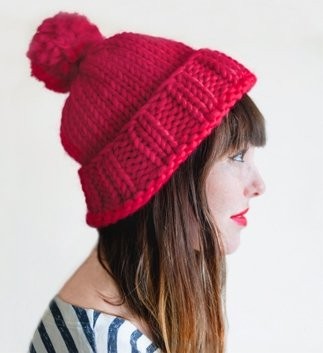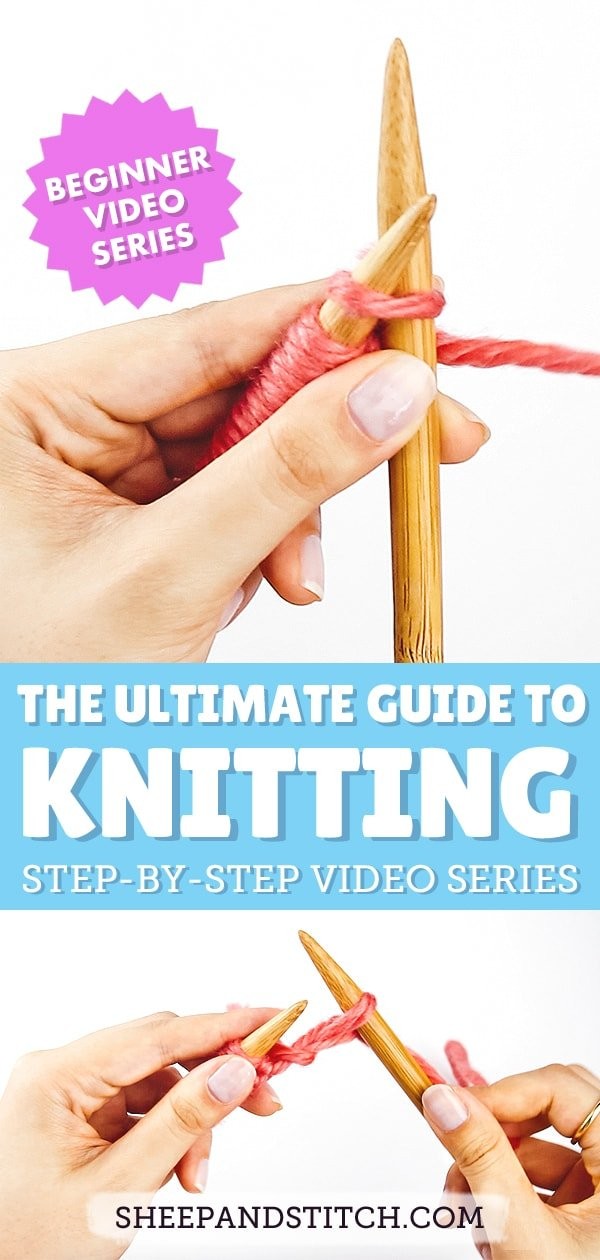Learning to knit is an enriching and rewarding hobby, and at LEARNS.EDU.VN, we’re here to guide you through every step of the process with comprehensive knitting tutorials and expert tips. Whether you’re a complete novice or looking to refine your skills, discover how to master the art of knitting, create beautiful projects, and unlock a world of creative possibilities. Explore the benefits of learning to knit, discover essential knitting techniques, and find resources for continued learning and skill development with knitting instruction, yarn crafts, and needlework projects.
1. Why Learn to Knit? Unveiling the Benefits of Knitting
Knitting isn’t just a hobby; it’s a gateway to a world of creativity, relaxation, and personal enrichment. Here’s why learning to knit might be one of the best decisions you make:
1.1 Stress Relief and Mindfulness
The repetitive motions of knitting can be incredibly meditative, helping to reduce stress and promote mindfulness. Studies have shown that engaging in crafts like knitting can lower heart rate and blood pressure, offering a calming escape from the pressures of daily life.
- Source: Riley, J., Corkhill, B., & Shakespeare, D. (2013). A qualitative study of the benefits of knitting for personal wellbeing in adults. British Journal of Occupational Therapy, 76(12), 514-522.
1.2 Boosting Creativity and Self-Expression
Knitting allows you to express your creativity through the colors, textures, and patterns you choose. From simple scarves to intricate sweaters, each project is a unique reflection of your personal style and artistic vision.
1.3 Enhancing Cognitive Function
Knitting requires focus, concentration, and problem-solving skills. As you learn new techniques and tackle more complex patterns, you’ll be exercising your brain and keeping your mind sharp.
1.4 Creating Meaningful Gifts
Handmade items have a special significance, and knitted gifts are no exception. Whether you’re knitting a cozy blanket for a loved one or a stylish hat for a friend, your creations will be treasured for their thoughtfulness and personal touch.
1.5 Building Community
Knitting is a social activity that connects people of all ages and backgrounds. Joining a knitting group or online forum can provide opportunities to share your passion, learn from others, and make new friends.
2. Getting Started: Essential Supplies for Aspiring Knitters
Before you can start knitting, you’ll need to gather a few essential supplies. Here’s a checklist of what you’ll need to get started:
2.1 Knitting Needles
Knitting needles come in a variety of sizes and materials, each suited for different types of yarn and projects. Here’s a breakdown of the most common types:
| Needle Type | Description | Best For |
|---|---|---|
| Straight Needles | Long, straight needles with a knob at one end to prevent stitches from slipping off. | Flat projects like scarves, blankets, and panels. |
| Circular Needles | Two needles connected by a flexible cable, allowing you to knit in the round or work on large projects. | Hats, sweaters, and other seamless items. |
| Double-Pointed Needles (DPNs) | Short, pointed needles used in sets of four or five for knitting small-diameter tubes in the round. | Socks, gloves, and the crowns of hats. |
| Needle Material | Affects how stitches slide. Options include wood (good grip), metal (faster), and plastic (affordable). | Personal preference and project type. Metal is good for speed, wood for controlling slippery yarns. |
| Needle Size | Indicated by mm or US sizes; choose based on yarn weight for correct gauge. | Determined by the yarn used. Check the yarn label for recommended needle size. |




For beginners, it’s recommended to start with a pair of straight needles in a medium size (US size 8 or 5mm) and a smooth material like bamboo or plastic.
2.2 Yarn
Yarn is the heart and soul of any knitting project. It comes in a wide range of fibers, weights, and colors, each offering its own unique characteristics. Here’s a quick overview of the most common yarn types:
| Yarn Fiber | Description | Best For |
|---|---|---|
| Wool | Warm, durable, and naturally elastic, wool is a classic choice for knitting projects. | Sweaters, hats, scarves, and blankets. |
| Cotton | Soft, breathable, and easy to care for, cotton yarn is ideal for warm-weather projects. | Dishcloths, baby clothes, and summer tops. |
| Acrylic | Affordable, machine-washable, and available in a wide range of colors, acrylic yarn is a versatile option for beginners. | Practice projects, blankets, and items that require frequent washing. |
| Alpaca | Luxurious, soft, and hypoallergenic, alpaca yarn is a splurge-worthy choice for special projects. | Shawls, scarves, and delicate garments. |
| Blend Fibers | Combine the properties of different fibers for enhanced qualities like softness and durability. | Projects where specific characteristics are desired (e.g., wool-silk blends for drape and warmth, cotton-acrylic for softness and washability). |
| Yarn Weight | Dictates the thickness and gauge; ranges from lace to jumbo. Match weight to pattern for correct fabric. | Follow pattern recommendations. Lighter weights for delicate items, heavier weights for quicker, bulkier projects. |
| Color Variety | Choose colors that inspire you and complement the project. Dye lots can vary, so buy enough from the same lot. | Consider the end use and recipient’s preferences. Variegated yarns add interest, solid colors show stitch definition. |
For your first project, choose a smooth, light-colored yarn in a medium weight (worsted or DK) to make it easier to see your stitches. LEARNS.EDU.VN offers detailed guides on selecting the perfect yarn for your needs.
2.3 Other Essential Tools
In addition to needles and yarn, you’ll also need a few other essential tools:
- Scissors: For cutting yarn.
- Tapestry Needle: For weaving in ends.
- Measuring Tape: For checking gauge and measuring your project.
- Stitch Markers: For marking important points in your pattern.
- Row Counter: For keeping track of your rows (optional but helpful).
3. Mastering the Basics: Essential Knitting Techniques
Once you have your supplies, it’s time to learn the basic knitting techniques. Here are the three most important stitches to master:
3.1 Casting On
Casting on is the process of creating the first row of stitches on your needle. There are several different methods for casting on, but the long-tail cast-on is a popular choice for beginners because it’s easy to learn and creates a neat, stretchy edge.
Steps for Long-Tail Cast-On:
- Hold the yarn with the tail end draped over your thumb and the working yarn draped over your index finger.
- Make a slip knot and place it on your needle.
- Insert the needle into the loop on your thumb, then scoop up the yarn on your index finger.
- Bring the yarn through the loop on your thumb and slide the stitch onto your needle.
- Repeat steps 3 and 4 until you have the desired number of stitches on your needle.
3.2 The Knit Stitch
The knit stitch is the foundation of most knitting projects. It creates a textured fabric with vertical ridges on one side (the right side) and horizontal ridges on the other side (the wrong side).
Steps for the Knit Stitch:
- Hold the needle with the cast-on stitches in your left hand and the empty needle in your right hand.
- Insert the right needle into the first stitch on the left needle, going from left to right.
- Wrap the yarn around the right needle, going from back to front.
- Use the right needle to draw the yarn through the stitch on the left needle, creating a new loop on the right needle.
- Slip the old stitch off the left needle, leaving the new stitch on the right needle.
- Repeat steps 2-5 for each stitch on the left needle.
3.3 Casting Off (Binding Off)
Casting off is the process of removing the stitches from your needle and securing the edge of your project. It creates a finished edge that prevents the fabric from unraveling.
Steps for Casting Off:
- Knit two stitches onto the right needle.
- Use the left needle to lift the first stitch on the right needle over the second stitch, effectively removing the first stitch from the needle.
- Knit one more stitch onto the right needle.
- Repeat step 2, lifting the first stitch over the second stitch.
- Continue knitting one stitch and lifting the previous stitch over it until only one stitch remains on the right needle.
- Cut the yarn, leaving a tail of about 6 inches.
- Thread the yarn tail through the loop on the needle and pull tight to secure the edge.
4. Troubleshooting Common Knitting Mistakes
As a beginner, you’re bound to make mistakes. Don’t worry, it’s all part of the learning process! Here are some common knitting mistakes and how to fix them:
4.1 Dropped Stitches
A dropped stitch occurs when a loop of yarn slips off your needle. If you catch it quickly, you can usually pick it up with your needle and continue knitting. If you don’t notice it right away, the stitch may unravel several rows down.
How to Fix a Dropped Stitch:
- Insert your knitting needle into the dropped stitch, going from front to back.
- Use a crochet hook or your fingers to pull the working yarn through the loop, recreating the missing stitch.
- Place the stitch back on your needle and continue knitting.
4.2 Adding a Stitch
An accidental increase usually happens when you are not paying close attention to your work, particularly with garter stitch, or when you are increasing intentionally, but lose track of where you are in the pattern.
How to Fix Adding a Stitch
- Carefully examine your knitting to locate the extra stitch.
- Once you’ve found it, use your knitting needles to carefully “unknit” the stitch, one row at a time, until you’ve removed the extra loop.
- Smooth out the area and continue knitting as normal.
4.3 Holes in Your Knitting
Holes in your knitting can be caused by a number of factors, such as dropped stitches, yarn overs, or uneven tension.
How to Prevent Holes:
- Be careful not to drop any stitches.
- Make sure you’re not accidentally creating yarn overs (extra loops of yarn on your needle).
- Maintain consistent tension throughout your project.
4.4 Uneven Tension
Uneven tension occurs when your stitches are either too tight or too loose, resulting in a fabric that’s bumpy or irregular.
How to Achieve Even Tension:
- Relax your grip on the needles and yarn.
- Make sure you’re not pulling the yarn too tightly as you knit.
- Practice makes perfect! The more you knit, the more consistent your tension will become.
5. Beginner Knitting Projects: Putting Your Skills to the Test
Now that you’ve learned the basics, it’s time to put your skills to the test with a simple knitting project. Here are a few ideas to get you started:
5.1 Garter Stitch Scarf
A garter stitch scarf is the perfect beginner project because it only requires one stitch (the knit stitch) and can be made in any length and width.
Materials:
- 1 skein of worsted weight yarn
- US size 8 (5mm) knitting needles
Instructions:
- Cast on 20 stitches.
- Knit every row until your scarf is the desired length.
- Cast off and weave in the ends.
5.2 Knit Dishcloth
A knit dishcloth is another easy and practical project that’s great for practicing your knitting skills.
Materials:
- 1 skein of cotton yarn
- US size 7 (4.5mm) knitting needles
Instructions:
- Cast on 30 stitches.
- Knit every row until your dishcloth is square.
- Cast off and weave in the ends.
5.3 Ribbed Headband
A ribbed headband is a stylish and functional accessory that’s perfect for keeping your ears warm in the winter.
Materials:
- 1 skein of worsted weight yarn
- US size 6 (4mm) knitting needles
Instructions:
- Cast on 15 stitches.
- *Knit 1, purl 1. Repeat from * to end of row.
- Repeat row 2 until your headband is the desired length.
- Cast off in rib and sew the ends together to form a loop.
6. Intermediate Knitting Techniques: Elevating Your Skills
Once you’ve mastered the basic knitting techniques, you can expand your skills with intermediate techniques such as:
6.1 Purl Stitch
The purl stitch is another fundamental stitch that creates a fabric with horizontal ridges on one side (the right side) and vertical ridges on the other side (the wrong side). When combined with the knit stitch, the purl stitch can be used to create a variety of textured patterns.
How to execute a Purl Stitch
- Hold the needle with the cast-on stitches in your left hand and the empty needle in your right hand.
- Insert the right needle into the first stitch on the left needle, going from right to left.
- Bring the yarn to the front of the work, between the needles.
- Wrap the yarn around the right needle, going from right to left.
- Use the right needle to draw the yarn through the stitch on the left needle, creating a new loop on the right needle.
- Slip the old stitch off the left needle, leaving the new stitch on the right needle.
- Repeat steps 2-6 for each stitch on the left needle.
6.2 Cables
Cables are created by crossing stitches over each other, resulting in a raised, rope-like design. They can add texture and visual interest to your knitting projects.
6.3 Lace
Lace knitting involves creating openwork patterns by strategically increasing and decreasing stitches. Lace projects can be delicate and intricate, perfect for shawls, scarves, and other lightweight garments.
6.4 Intarsia
Intarsia is a colorwork technique that allows you to create blocks of color within your knitting. It’s often used for creating pictures or geometric designs on sweaters, blankets, and other projects.
7. Advanced Knitting Techniques: Becoming a Knitting Expert
For those knitters looking to achieve expert status, there are several complex techniques to master:
7.1 Brioche
Brioche knitting creates a thick, squishy fabric with a distinctive ribbed texture. It’s often used for cowls, scarves, and other warm accessories.
7.2 Double Knitting
Double knitting creates a reversible fabric with two layers of knitting worked simultaneously. It’s perfect for projects like blankets, scarves, and reversible sweaters.
7.3 Fair Isle
Fair Isle is a colorwork technique that involves knitting with two or more colors in the same row, creating intricate patterns and designs. It’s often used for sweaters, hats, and other accessories.
7.4 Modular Knitting
Modular knitting involves creating individual pieces of knitting and then joining them together to form a larger project. It’s a great way to use up leftover yarn or create unique and unconventional designs.
8. Tips for Improving Your Knitting Skills
Here are a few tips to help you improve your knitting skills and become a more confident and accomplished knitter:
8.1 Practice Regularly
The more you knit, the better you’ll become. Try to set aside some time each day or week to practice your knitting skills, even if it’s just for a few minutes.
8.2 Take Classes or Workshops
Taking a knitting class or workshop is a great way to learn new techniques and get personalized feedback from an experienced instructor. Check your local yarn stores or community centers for knitting classes in your area.
8.3 Join a Knitting Group
Joining a knitting group is a great way to connect with other knitters, share your passion, and learn from each other. Many yarn stores and community centers host knitting groups that meet regularly.
8.4 Watch Online Tutorials
There are countless online tutorials that can teach you new knitting techniques and provide step-by-step instructions for specific projects. YouTube is a great resource for finding knitting tutorials.
8.5 Read Knitting Books and Magazines
Knitting books and magazines can provide inspiration, patterns, and valuable information about knitting techniques and materials. Check your local library or bookstore for knitting publications.
9. Knitting Patterns and Resources: Where to Find Inspiration
Once you’ve got some knitting experience, you’ll probably want to find patterns so you can try new projects! Here’s where to find knitting patterns and resources:
9.1 Online Pattern Databases
Websites like Ravelry and LoveCrafts host a vast collection of knitting patterns, from simple beginner projects to complex designs for experienced knitters. These websites allow you to search for patterns by yarn weight, needle size, and other criteria.
9.2 Knitting Books and Magazines
Knitting books and magazines are another great source of patterns and inspiration. Look for publications that cater to your skill level and interests.
9.3 Independent Designers
Many independent designers sell their knitting patterns online through their own websites or platforms like Etsy and Payhip. Supporting independent designers is a great way to discover unique and innovative patterns.
9.4 Knitting Blogs
Knitting blogs often feature free patterns, tutorials, and tips for knitters of all levels. Following knitting blogs can help you stay up-to-date on the latest trends and techniques.
10. The Future of Knitting: Trends and Innovations
The world of knitting is constantly evolving, with new trends and innovations emerging all the time. Here are a few of the trends and innovations that are shaping the future of knitting:
10.1 Sustainable Knitting
As awareness of environmental issues grows, more and more knitters are embracing sustainable practices, such as using eco-friendly yarns, reducing waste, and supporting ethical brands.
10.2 Technology-Enhanced Knitting
Technology is playing an increasingly important role in knitting, with innovations like computerized knitting machines, digital pattern design tools, and online knitting communities.
10.3 Inclusive Knitting
The knitting community is becoming more inclusive and welcoming to knitters of all backgrounds, abilities, and identities. This includes promoting diversity in patterns, yarns, and designs, as well as creating safe and supportive spaces for knitters to connect and share their experiences.
10.4 Mindful Knitting
With the rise of mindfulness and self-care practices, many knitters are turning to knitting as a way to relax, de-stress, and connect with their inner selves. Mindful knitting involves paying attention to the present moment, focusing on the sensations of the yarn and needles, and letting go of distractions and worries.
Here’s a table summarizing these recent updates:
| Category | Trend/Innovation | Description |
|---|---|---|
| Sustainability | Eco-Friendly Yarns | Using organic, recycled, or plant-based fibers. |
| Waste Reduction | Employing techniques to minimize yarn scraps and packaging waste. | |
| Technology | Computerized Knitting Machines | Automating complex patterns and designs. |
| Digital Pattern Design Tools | Software for creating and modifying knitting patterns. | |
| Inclusivity | Diversity in Design | Featuring patterns and models that represent a wide range of backgrounds and abilities. |
| Mindfulness | Mindful Knitting Practices | Focusing on the sensory experience of knitting to reduce stress and enhance well-being. |
| Online Learning Tools | Interactive Knitting Platforms | Websites and apps that offer step-by-step guidance, video tutorials, and personalized feedback. |
| Fiber Innovation | Novel Yarn Blends | Combining traditional fibers with new materials like seaweed, milk protein, or recycled plastics for unique textures. |
| Community & Collaboration | Virtual Knitting Circles | Online groups that host live knitting sessions, pattern swaps, and skill-sharing opportunities. |
FAQ: Your Questions About Learning to Knit Answered
Q1: Is knitting hard to learn?
Knitting can seem intimidating at first, but with patience and practice, anyone can learn the basics. Start with simple projects and gradually work your way up to more challenging designs.
Q2: What’s the best yarn for beginners?
A smooth, light-colored yarn in a medium weight (worsted or DK) is ideal for beginners. Avoid fuzzy or textured yarns, as they can be difficult to work with.
Q3: What size needles should I use?
The recommended needle size will depend on the yarn you’re using. Check the yarn label for guidance.
Q4: How do I fix a dropped stitch?
Insert your knitting needle into the dropped stitch, going from front to back. Use a crochet hook or your fingers to pull the working yarn through the loop, recreating the missing stitch.
Q5: How do I prevent holes in my knitting?
Be careful not to drop any stitches, make sure you’re not accidentally creating yarn overs, and maintain consistent tension throughout your project.
Q6: How do I weave in the ends of my yarn?
Thread the yarn tail through a tapestry needle and weave it through the stitches on the wrong side of your project. Trim the excess yarn close to the fabric.
Q7: Where can I find knitting patterns?
Online pattern databases, knitting books, magazines, and independent designers are all great sources of knitting patterns.
Q8: How can I improve my knitting skills?
Practice regularly, take classes or workshops, join a knitting group, watch online tutorials, and read knitting books and magazines.
Q9: What are some sustainable knitting practices?
Use eco-friendly yarns, reduce waste, and support ethical brands.
Q10: How can I find a knitting group near me?
Check your local yarn stores or community centers for knitting groups in your area.
Knitting is more than just a craft; it’s a journey of creativity, self-discovery, and community. As you embark on your knitting adventure, remember to be patient with yourself, embrace mistakes as learning opportunities, and never stop exploring new techniques and patterns. With dedication and a willingness to learn, you’ll be amazed at what you can create.
Ready to take your first step into the wonderful world of knitting? Visit LEARNS.EDU.VN today to discover a wealth of resources, from beginner-friendly tutorials to advanced techniques, and unlock your creative potential. Our expert instructors are here to guide you every step of the way, providing personalized support and inspiration to help you achieve your knitting goals. Don’t wait any longer – start your knitting journey with LEARNS.EDU.VN and experience the joy of creating something beautiful with your own two hands. Contact us at 123 Education Way, Learnville, CA 90210, United States, Whatsapp: +1 555-555-1212. Website: learns.edu.vn.